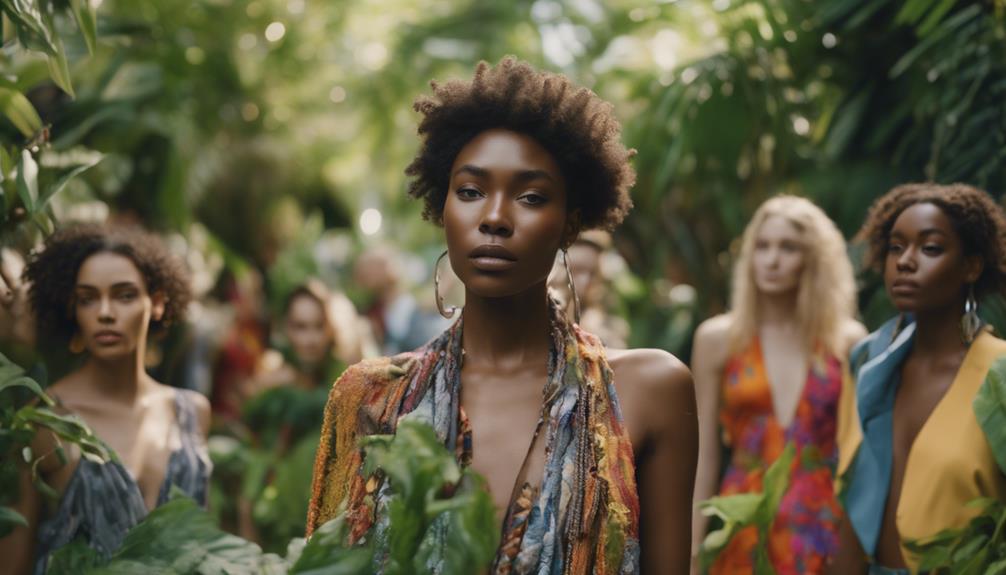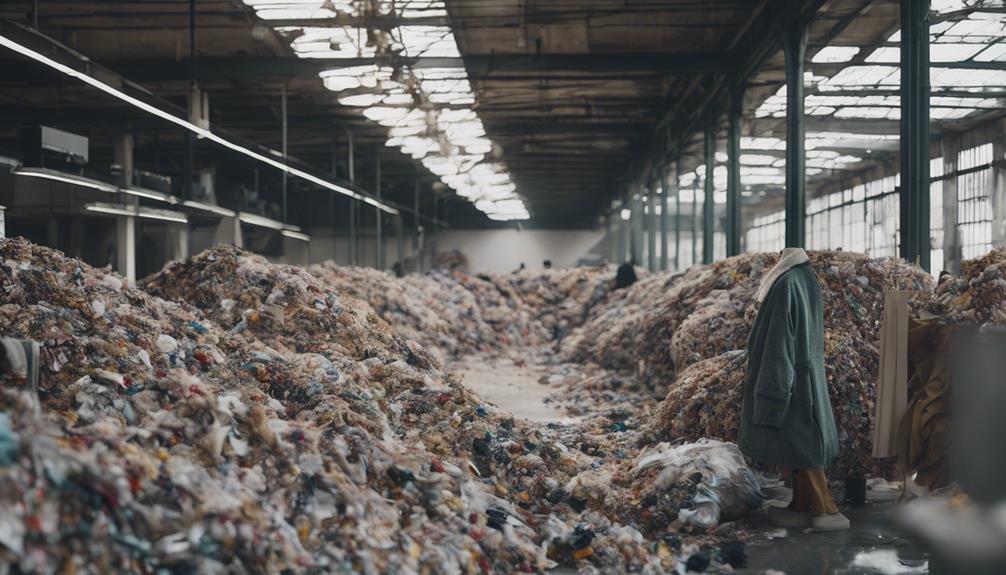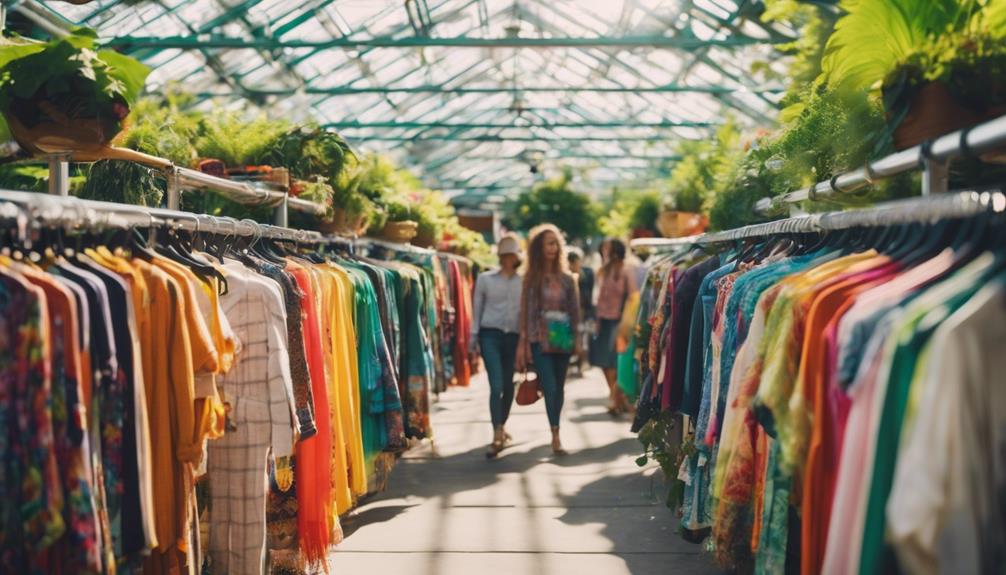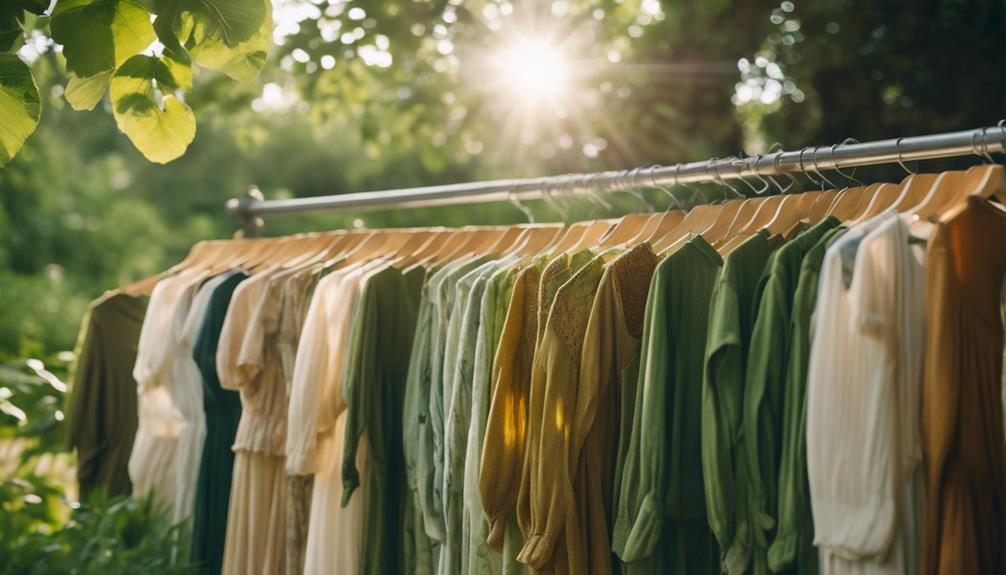Mango claims to prioritize sustainability, however, there are significant gaps between their claims and reality. While 44% of their ‘Committed’ collection is made from eco-friendly materials, they still have not made sufficient progress in reducing environmental impacts and eliminating hazardous chemicals. Concerns persist around transparency, with a low score of only 22 out of 100. Questionable labor practices and animal welfare standards have also been flagged, including instances of forced labor and inadequate sourcing policies. Despite Mango’s goal of reaching 100% sustainable materials by 2025, doubts remain about their commitment to sustainability. If you are curious about how this might influence your decisions, there is more to learn about Mango’s sustainability initiatives.
Key Takeaways
- Mango's 'Committed' collection has only 44% of products made from eco-friendly materials, indicating limited sustainability progress.
- The brand aims for 100% sustainable cotton, linen, and polyester by 2025, but currently lacks sufficient action on hazardous chemicals.
- Transparency issues persist, with a low rating of 22 out of 100, raising concerns about labor practices and supply chain accountability.
- Mango's animal welfare standards are rated 'Not Good Enough,' with no formal policy for ethical sourcing of animal materials.
Overview of Mango's Sustainability Claims
Mango frequently touts its commitment to sustainability, claiming that 44% of its products are made from eco-friendly materials as part of its 'Committed' collection. While this sounds promising, you should be cautious about potential greenwashing. The brand's transparency rating is only 22 out of 100, raising questions about the authenticity of its sustainability claims.
Mango's membership in the Ethical Trading Initiative (ETI) and participation in the Better Cotton Initiative (BCI) suggest a commitment to ethical practices, but the lack of substantial verification leaves you wondering about the real impact. Although they aim to achieve 100% sustainable cotton, linen, and polyester by 2025, their current efforts fall short, especially regarding meaningful water usage reduction.
Moreover, Mango hasn't made significant strides in eliminating hazardous chemicals from its supply chain, which can undermine its sustainability narrative. While the brand reports on water usage and waste management strategies, their overall approach to minimizing environmental impact seems lacking.
It's crucial to critically evaluate these claims to discern whether Mango's sustainability efforts are genuinely impactful or merely a marketing strategy.
Environmental Impact Assessment

When evaluating Mango's environmental impact, you'll notice their use of eco-friendly materials is still limited, with only 44% of products currently meeting sustainable standards.
They've set ambitious goals to achieve 100% sustainable cotton, linen, and polyester by 2025, but their water consumption strategies raise concerns.
Additionally, while they report on waste management, meaningful actions to address hazardous chemicals in their production processes are noticeably absent.
Eco-Friendly Material Usage
While Mango incorporates some eco-friendly materials, only 44% of its products currently meet sustainable standards, highlighting the need for more considerable advancements in its environmental practices. You might be wondering how this affects the brand's overall sustainability. Here are some key points to contemplate:
Mango's commitment includes achieving 100% sustainable cotton, linen, and polyester by 2025.
The brand has recycling initiatives and is exploring circular fashion, yet progress remains slow.
Despite using sustainable materials, the environmental impact is rated as 'Not Good Enough.'
There's a lack of meaningful action to eliminate hazardous chemicals from production processes.
The transparency rating in the Fashion Transparency Index is just 22/100, indicating insufficient clarity about Mango's sustainability efforts.
These factors collectively show that while Mango is taking steps towards eco-friendly materials and sustainable practices, it's clear that more must be done.
Addressing water usage and enhancing transparency are critical to improving its overall environmental impact.
With a more robust commitment to sustainability, Mango could considerably elevate its standing in the fashion industry.
Carbon Footprint Goals
Achieving a 100% sustainable use of cotton, linen, and polyester by 2025 is an essential goal for Mango in its efforts to reduce carbon emissions. This commitment to sustainability is important, especially since Mango's current environmental impact rating is 'Not Good Enough.' While 44% of its products utilize sustainable materials, the brand still lacks clear targets for overall emissions reduction.
You might find it concerning that Mango's transparency rating stands at only 22 out of 100. Although the company is a member of the Ethical Trading Initiative and participates in the Better Cotton Initiative, its efforts haven't yet translated into substantial progress. Additionally, even though Mango has reported on water usage, there's no evidence of initiatives to actively reduce water consumption, which is critical for a thorough environmental impact strategy.
To truly address its carbon footprint, Mango must set specific, measurable goals and enhance its transparency regarding sustainability practices. As a consumer, understanding these aspects can help you make informed choices about whether Mango aligns with your values on sustainable fashion.
Waste Management Strategies
Mango's waste management strategies are essential for reducing its environmental impact, yet the brand still struggles to implement significant initiatives that truly address sustainability. While it has made strides in using sustainable materials, there are critical areas where improvement is necessary.
- 44% of products incorporate sustainable materials, showing a commitment to better practices.
- The goal of achieving 100% sustainable cotton, linen, and polyester by 2025 reflects an effort to enhance waste management.
- Despite initiatives for recycling and circular fashion, meaningful actions to eliminate hazardous chemicals are lacking.
- The brand's environmental impact rating is deemed 'Not Good Enough,' indicating insufficient adherence to sustainability standards.
It's clear that while Mango is on the path toward better waste management strategies, more concrete actions are needed to mitigate its environmental impact.
Labor Practices and Transparency Issues

Labor practices at Mango raise significant concerns, especially with its low transparency score and reports of inadequate worker protections.
With a labor rating classified as 'Not Good Enough' and a transparency score of only 21-30% in the Fashion Transparency Index, you might question the brand's commitment to ethical labor practices.
While some of its supply chains are certified by BSCI and SMETA, Mango hasn't provided a thorough list of suppliers, which raises alarming issues related to forced labor and gender equality.
Mango conducts audits to verify compliance with labor laws, but there's little evidence supporting that its workers receive a living wage or adequate COVID-19 protection policies.
Criticism regarding labor rights in some factories highlights the urgent need for better worker protections and fair compensation.
Despite being a member of the Ethical Trading Initiative (ETI), Mango's ethical labor practices remain under scrutiny due to limited transparency and accountability throughout its supply chain.
If you care about sustainable fashion, these labor practices may influence your perception of Mango as a responsible brand.
Animal Welfare Standards

Animal welfare standards at Mango present significant concerns, particularly given the brand's use of various animal-derived materials without a robust policy to guarantee their ethical sourcing. While they've discontinued fur, angora, and exotic animal skin, the lack of transparency in their supply chain raises serious questions about the humane treatment of animals involved in production.
Here are key points to reflect on regarding Mango's animal welfare practices:
- Use of animal products: Mango incorporates wool, leather, exotic animal hair, and down in its items.
- Lack of formal policy: Although there's a general statement about minimizing animal suffering, no formal guidelines support this.
- Rating concerns: Their animal welfare practices receive a 'Not Good Enough' rating, indicating significant room for improvement.
- Transparency issues: There's insufficient documentation regarding the sourcing of animal-derived materials.
Ethical Certifications and Partnerships

When you look at Mango's ethical certifications and partnerships, you'll find the brand's involvement with the Ethical Trading Initiative and the Better Cotton Initiative shows a commitment to responsible practices.
However, there are gaps in transparency and depth within their ethical Code of Conduct.
Let's explore how these certifications and partnerships shape Mango's sustainability efforts.
Current Certifications Overview
Mango's commitment to ethical practices is reflected in its memberships with organizations like the Ethical Trading Initiative (ETI) and the Better Cotton Initiative (BCI). However, its limited third-party certifications raise questions about the depth of its sustainability efforts.
In the current certifications overview, you should consider the following points:
- Membership in ETI and participation in BCI show some level of ethical commitment.
- The Fashion Transparency Index scores Mango between 21-30%, indicating a need for better supplier disclosure.
- Limited third-party certifications raise concerns about forced labor and gender equality in its supply chain.
- Some supply chains are certified by BSCI and SMETA, but details remain sparse.
With these factors in mind, it's crucial to critically evaluate Mango's ethical practices. While the brand has made strides, the lack of thorough certifications and transparency suggests that significant improvements are still needed to fully embrace sustainable fashion. One way Mango could improve its ethical practices is by obtaining certifications from reputable organizations and being more transparent about its supply chain. This would reassure customers that the brand is committed to sustainable and ethical practices. Additionally, Mango could also explore partnerships with environmental organizations and initiatives to further demonstrate its dedication to sustainable fashion. For example, Mango could collaborate with organizations that specialize in eco-friendly textile production or offer flawless selftanners for fair skin to promote a more sustainable and ethical approach to beauty products.
You'll want to keep these issues in perspective when reviewing whether Mango truly stands for sustainability.
Partnership With NGOS
Engaging with NGOs, Mango aims to bolster its sustainability initiatives and enhance ethical practices within its supply chain. By participating in the Better Cotton Initiative, the brand promotes sustainable cotton production, helping to reduce the environmental impact of cotton farming. Additionally, as a member of the Ethical Trading Initiative, Mango focuses on improving labor conditions and guaranteeing fair trade practices throughout its operations.
While these partnerships reflect a commitment to better practices, there's still a notable lack of transparency regarding Mango's full list of suppliers and the ethical practices in all factories. This gap raises questions about the effectiveness of their collaborations and the actual impact on labor conditions.
Although Mango has made strides through its memberships and initiatives, assessments indicate that their overall sustainability efforts are rated as 'Not Good Enough', highlighting significant room for improvement.
To genuinely transform its supply chain, Mango must enhance its transparency and guarantee that all factories adhere to ethical practices, making their partnerships with NGOs truly effective in achieving sustainable fashion.
Ethical Trading Initiatives
To strengthen its commitment to ethical practices, Mango actively participates in various ethical trading initiatives, including the Ethical Trading Initiative and the Better Cotton Initiative. These partnerships aim to enhance worker rights and promote sustainability across global supply chains. However, there are notable gaps in their approach.
Mango's involvement with the Ethical Trading Initiative highlights its focus on improving worker rights.
The Better Cotton Initiative helps the brand support sustainable cotton farming practices.
Some of Mango's supply chains are certified by BSCI and SMETA, but many lack transparency.
Transparency concerns arise from the absence of an all-encompassing supplier list.
Limited third-party certifications indicate a need for more rigorous ethical partnerships.
Despite these initiatives, Mango's transparency rating is only 22 out of 100, raising questions about its genuine commitment to ethical trading initiatives.
While the brand is making strides, it still faces criticism for its insufficient transparency and sustainability efforts.
If Mango wants to prove its dedication to ethical practices, it'll need to enhance its transparency and broaden its third-party certifications in the future.
Consumer Awareness and Ethical Choices

As consumers become more aware of sustainability issues, they're increasingly making ethical choices that support brands committed to genuine eco-friendly practices. This growing consumer awareness is vital, especially when maneuvering the fast fashion landscape.
Brands like Mango often face criticism for greenwashing, where their misleading sustainability claims don't align with their actual practices. For instance, Mango uses only 44% sustainable materials, coupled with a transparency rating of just 22/100. The Fashion Transparency Index scores the brand at a mere 21-30%, revealing significant gaps in supply chain transparency and ethical labor practices.
As a conscious shopper, you might feel overwhelmed, but there are ethical alternatives available that prioritize both sustainable materials and fair labor practices. Brands like MATE the Label and A.BCH exemplify this commitment and offer viable options to take into account.
Organizations like Greenpeace continue to scrutinize major brands, highlighting the importance of informed consumer choices. By choosing to support brands that genuinely uphold ethical practices, you can help drive meaningful change in the fashion industry and encourage others to do the same. Your purchasing power can influence the future of sustainable fashion.
Alternatives to Mango

With growing concerns about Mango's sustainability claims, exploring ethical alternatives that prioritize genuine eco-friendly practices is more important than ever.
You can choose from several brands that embody sustainable values and guarantee ethical production. Here are some options to take into account:
- MATE the Label: Offers GOTS certified organic fabrics and emphasizes transparency in their production practices.
- A.BCH: An Australian-made brand that utilizes renewable materials and champions circular fashion principles, reducing waste.
- Mila.Vert: Operates on a minimalist pre-order system, effectively minimizing overproduction and using sustainable fabrics.
- Dorsu: Specializes in everyday basics produced in Cambodia, with a commitment to fair wages and ethical labor conditions.
Criticism and Controversies

Mango's reputation has suffered considerably due to ongoing controversies regarding its labor practices and questionable sustainability claims. The brand's association with the tragic 2013 Rana Plaza factory collapse raises serious ethical concerns, especially since it hasn't adequately compensated victims' families. Critics argue that Mango engages in greenwashing, as its sustainability claims, like the 'Committed' collection, lack substantial progress and transparency.
With a transparency rating of only 22/100, Mango falls short in providing an extensive list of suppliers or details about labor practices in its supply chain. While 44% of its products utilize sustainable materials, the overall environmental impact is deemed 'Not Good Enough,' revealing insufficient commitment to genuine sustainability efforts.
Moreover, although Mango participates in initiatives like the Better Cotton Initiative, ongoing issues surrounding labor rights persist. Allegations of not ensuring living wages and adequate worker protections overshadow any positive claims the brand makes.
As you consider your purchasing decisions, these criticisms highlight the need for greater accountability and transparency in the fashion industry, particularly regarding Mango's practices and claims.
Future Sustainability Goals

Addressing the criticisms it faces, Mango has set ambitious sustainability goals aimed at improving its environmental impact and labor practices. You'll find that these goals reflect a shift towards more ethical and sustainable practices, although skepticism remains about their effectiveness due to concerns of greenwashing.
Here are some key objectives Mango is focusing on:
- Achieving 100% sustainable cotton, linen, and polyester by 2025 to reduce its carbon footprint.
- Increasing the use of sustainable materials, with 44% of products currently meeting this standard.
- Enhancing recycling efforts and implementing circular fashion initiatives to minimize waste.
- Developing more transparent practices to effectively address environmental impacts and labor conditions.
While Mango is making strides, it's essential to keep an eye on these goals. Transparency and genuine commitment will be key in determining whether Mango can truly evolve into a leader in sustainable fashion.
You'll want to watch for specific actions and updates to see how well the brand meets its promises.
Frequently Asked Questions
Is Mango Actually Sustainable?
You might find Mango's sustainability claims questionable. While they use some sustainable materials, their overall practices, transparency, and labor conditions raise concerns. You should consider the brand's efforts versus the criticisms before making a decision.
Is Mango Fashion Ethical?
Mango's ethics are like a patchwork quilt—colorful yet frayed. You'll find labor rights issues and transparency gaps, leaving you questioning their commitment to fair practices. It's essential to dig deeper before supporting their brand.
Is Mango Greenwashing?
You might wonder if Mango's sustainability claims are genuine or just greenwashing. With low transparency ratings and questionable practices, it's crucial to scrutinize their efforts before accepting their claims at face value.
Is Mango Fast Fashion or Not?
With around 18,000 items in its product line, Mango's clearly a fast fashion retailer. You'll find trendy pieces quickly, but keep an eye on their sustainability claims—they often lack transparency and genuine commitment.
Conclusion
In the world of fashion, Mango presents itself as a champion of sustainability, but it's crucial to peel back the layers.
While they tout green initiatives, the reality mightn't be as ripe as it seems.
You've got the power to choose wisely—explore alternatives that align with your values.
Remember, true sustainability isn't just a trend; it's a commitment to the planet and people.
Let your wardrobe reflect your ideals, and be the change you want to see!









